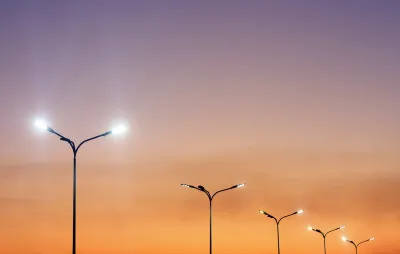Switching to energy-efficient LEDs and using tech to program when and how street lighting operates can save cities millions in electricity expenses and bring down carbon emissions.

According to an article in Cities Today, smart street lighting technology could help cities reduce their carbon emissions and adjust urban lighting to limit disruption to local ecosystems and human circadian rhythms.
Street lighting is one of the largest sources of energy consumption and emissions under the direct control of cities: public street and area lighting account for up to 40 percent of electricity consumed by municipalities, and for about 1-3 percent of total electricity demand, as reported by The Climate Group.
Smart streetlight management can add another tool to local governments’ toolboxes, the article notes. “The first step is turning streetlights to energy-efficient LED lamps, immediately saving up to 70 percent in power consumption and related costs.”
By using technology to manage when lighting turns on and off and how much energy it uses, cities can save even more. According to the article, “Remote on-off control, dimming, and scheduling functions are quick wins of IoT street lighting solutions, making them one of the most actionable and ready-to-implement technologies for cities to transition to a low-carbon economy.”
FULL STORY: Smart lighting is more than energy saving

Alabama: Trump Terminates Settlements for Black Communities Harmed By Raw Sewage
Trump deemed the landmark civil rights agreement “illegal DEI and environmental justice policy.”

Planetizen Federal Action Tracker
A weekly monitor of how Trump’s orders and actions are impacting planners and planning in America.

The 120 Year Old Tiny Home Villages That Sheltered San Francisco’s Earthquake Refugees
More than a century ago, San Francisco mobilized to house thousands of residents displaced by the 1906 earthquake. Could their strategy offer a model for the present?

Ken Jennings Launches Transit Web Series
The Jeopardy champ wants you to ride public transit.

BLM To Rescind Public Lands Rule
The change will downgrade conservation, once again putting federal land at risk for mining and other extractive uses.

Indy Neighborhood Group Builds Temporary Multi-Use Path
Community members, aided in part by funding from the city, repurposed a vehicle lane to create a protected bike and pedestrian path for the summer season.
Urban Design for Planners 1: Software Tools
This six-course series explores essential urban design concepts using open source software and equips planners with the tools they need to participate fully in the urban design process.
Planning for Universal Design
Learn the tools for implementing Universal Design in planning regulations.
Clanton & Associates, Inc.
Jessamine County Fiscal Court
Institute for Housing and Urban Development Studies (IHS)
City of Grandview
Harvard GSD Executive Education
Toledo-Lucas County Plan Commissions
Salt Lake City
NYU Wagner Graduate School of Public Service





























